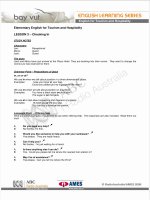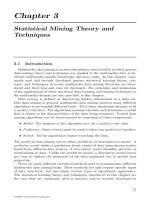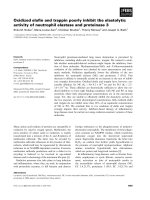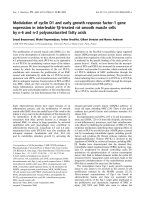minerals and mining 3
Bạn đang xem bản rút gọn của tài liệu. Xem và tải ngay bản đầy đủ của tài liệu tại đây (178.54 KB, 75 trang )
Minerals
Minerals
• minerals are elements of the periodic
table
• more than 25 have been isolated
• 21 elements have been shown to be
essential (excluding C,H, and O)
• minerals make up about 4 to 5% of body
weight (for a 70 kg individual: 2.8 kg)
• many minerals are found in ionic form
(others as ligands or covalent
compounds)
Minerals
• Two categories:
• macrominerals > 0.005%
• microminerals < 0.005%
• macrominerals are essential at levels of
100mg or more per day for human adults
• microminerals are often referred to as
trace elements
Macrominerals
Ca
P
S
K
Cl
Na
Mg
calcium
phosphorus
sulfur
potassium
chloride
sodium
magnesium
1200 grams
860 grams
300 grams
180 grams
74 grams
64 grams
25 grams
Microminerals
F
Zn
Cu
I
Cr
Co
Si
fluorine
zinc
copper
iodine
chromium
cobalt
silicon
2.6 V
2.0 Sn
0.1 Se
0.025 Mn
0.006 Ni
0.0015Mo
0.024
vanadium 0.018
tin
0.017
selenium 0.013
manganese 0.012
nickel
0.010
molybdenum 0.009
Other microminerals found in
humans
Sr (strontium)
Br (bromine)
Au (gold)
Ag (silver)
Al (aluminum)
Bi (bismuth)
As (arsenic)
B (boron)
the function of these minerals has not been
established as of to date
Scientific development which have
contributed to trace element knowledge
• design of highly purified and specially
constituted diets
• advances in analytical measurements
•
•
•
•
•
•
colorimetruy
fluorimetry
flame photometry
neutron activation analysis
atomic absoption spectroscopy
microwave excitation emission spectroscopy
• isolation and study of metalloenzymes
Functions of minerals
• provide a suitable medium for cellular
activity
– permeability of membranes
– irritability of muscles and nerve cells
• play a primary role in osmotic
phenomenon
• involved in acid base-balance
• confer rigidity and hardness to certain
tissues (bones and teeth)
• become part of specialized compounds
Metalloenzymes
•
•
•
•
•
metal is firmly bound
metal to protein ratio is constant
metal to enzyme activity ratio is constant
metal is unique
no enzyme activity without metal
Metalloenzymes
Examples of metalloenzymes:
–
–
–
–
–
superoxide dismutase (Zn and Cu)
carboxypeptidase A (Zn)
carbonic anhydrase (Zn)
cytochrome oxidase (Fe and Cu)
xanthine oxidase (Co and Fe)
Metal-activated enzymes
•
•
•
•
•
metal is reversibly bound
metal to protein ratio is variable
metal to enzyme activity ratio is variable
metal is not necessarily unique
enzyme activity may exit without metal
Metal-activated ezymes
• Examples of metal-activated enzymes
– creatine kinase (Mg, Mn, Ca or Co)
– glycogen phosphorylase kinase (Ca)
– salivary and pancreatic alpha-amylases (Ca)
The electrolytes
• There are 3 major electrolytes:
– sodium
– potassium
– chloride
Sodium (Na)
• Sodium is the principal cation in
extracellular fluids
• functions include:
•
•
•
•
•
osmotic equilibrium
acid-base balance
carbon dioxide transport
cell membrane permeability
muscle irritability
Sodium (Na)
• food sources: table salt, salty foods
(potato chips, pretzels, etc.), baking soda,
milk
• absorption and metabolism:
– readily absorbed
– excreted in the urine and sweat
– aldosterone increases reabsorption in remal
tubules
Sodium (Na)
• RDA for adults: 1.1 to 3.3 gm/day
• sodium deficiency:
– dehydration
– acidosis
– tissue atrophy
• sodium excess:
– edema (hypertonic expansion )
– hypertension
Sodium (Na)
• Sodium supplements:
– usually used to replace sodium and chloride
lost through perspiration during high heat
•
•
•
•
•
•
Thermotabs
Slo-salt
Heatrol
Lytren solution
Pedialyte solution
Gatorade and other sports drinks
Potassium (K)
• Potassium is the principal cation in
intracellular fluid
• functions:
–
–
–
–
–
buffer constituent
acid-base balance
water balance
membrane transport
neuromuscular irritability
Potassium
• Food sources: vegetables, fruit (bananas),
whole grains, meat, milk
• absorption and metabolism:
– readily absorbed (more so than sodium)
– intracellular
– secreted by kidney (also in sweat)
• RDA for adults: 1.5 - 4.5 gm/day
Potassium
• deficiency (hypokalemia)
– causes:
•
•
•
•
increased renal excretion (diuretics)
primary aldosteronism
severe vomiting and diarrhea
cutaneous losses via perspiration
– symptoms:
• profound weakness of skeletal muscles (paralysis
and impaired respiration
• weakness of smooth muscles
• cardiac anomalies: AV block, cardiac arrest
Potassium
• excess (hyperkalemia)
– causes:
• sudden increased intake
• severe tissue trauma and burns
• acute and chronic acidosis
– symptoms:
• weakness and paralysis
• cardiac anomalies (impaired conduction,
fibrillations, cardiac arrest)
Potassium supplements
• Oral products:
– tablets: potassium chloride, potassium
gluconate, Slow-K
– effervescent tablets: K-Lyte, K-Lor,
Kaochlor
– parenteral products: usually administered
by slow IV infusion (KCl and K acetate)
Treatment of hyperkalemia
• reverse cardiotoxic effects:
– calcium gluconate IV
• increase potassium uptake by cells:
– dextrose (IV)
– insulin (IV)
– sodium bicarbonate (IV)
• remove excess potassium from the body:
– sodium polystyrene sulfonate (Kayexalate)
Chloride (Cl)
• an essential anion
• closely connected with sodium in foods,
body tissues and fluids and excretions
• readily absorbed along with sodium
• excreted mainly in the kidneys (~ 2% in
feces and ~ 4-5% in perspiration )
• important for osmotic balance, acid-base
balance and in the formation of gastric
HCl
Chloride (Cl)
• Deficiency of chloride:
–
–
–
–
hypochloremic alkalosis
hypovolemia
pernicious vomiting
psychomotor disturbances









